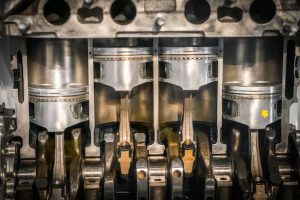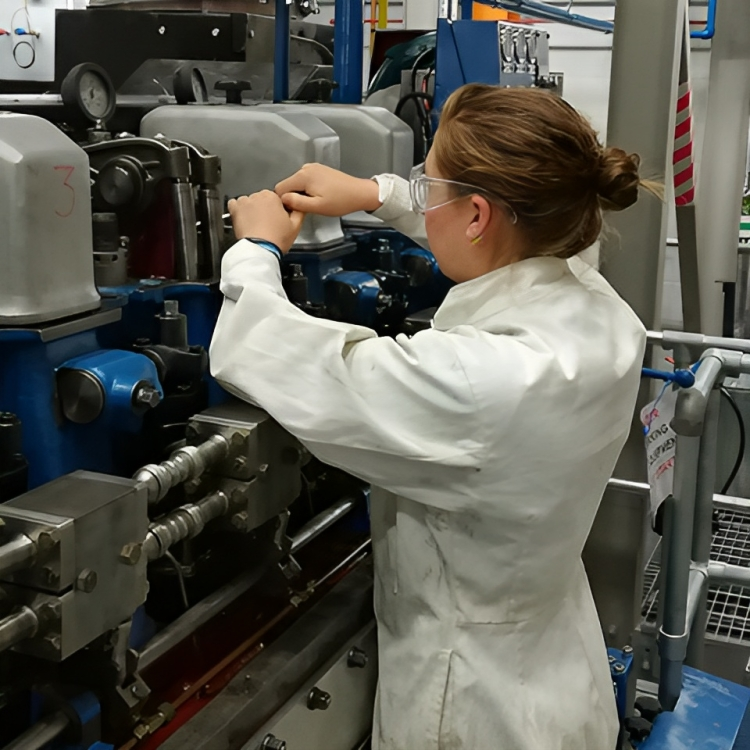Marine diesel engines are the primary source of propulsion for most merchant vessels, making them one of the most critical systems on board. These engines are complex machines that convert the chemical energy of fuel into mechanical energy to drive the ship’s propeller. To ensure optimal performance, ship engineering officers must possess a deep understanding of diesel engine operation, maintenance, troubleshooting, and diagnostics. In this chapter, we will explore the key components and operation of marine diesel engines and the essential maintenance practices that ship engineers must follow to ensure the longevity and efficiency of these critical systems.

Operation of Marine Diesel Engines
Marine diesel engines operate on the principle of internal combustion, where fuel is ignited inside a combustion chamber to produce a high-pressure explosion that drives a piston or turns a turbine. The power generated is transferred to the ship’s propeller, allowing the vessel to move through the water. Understanding the operational cycle and components of a diesel engine is crucial for maintaining its performance and reliability.
- Two-Stroke and Four-Stroke Engines
Marine diesel engines come in two main types: two-stroke and four-stroke engines.- Two-stroke engines are typically used in large, slow-speed ships such as tankers and bulk carriers. These engines complete a power cycle in just two strokes of the piston, providing more torque at lower speeds, making them ideal for large vessels that require significant power to move heavy loads.
- Four-stroke engines, on the other hand, are more common in medium-speed vessels like ferries or smaller cargo ships. These engines complete a power cycle in four strokes, offering a smoother operation at higher speeds but with less torque compared to two-stroke engines.
Engineering officers must understand the differences between these engine types, including their fuel consumption, power output, and maintenance requirements.

Marine two-stroke diesel engines
- Fuel Injection Systems
In diesel engines, the fuel injection system plays a critical role in determining the engine’s efficiency and performance. Fuel injectors deliver fuel into the combustion chamber at high pressure, atomizing it to ensure efficient combustion.
The timing and quantity of fuel injection must be precisely controlled to optimize combustion. Engineering officers must monitor and adjust fuel injection parameters to maintain efficient engine operation and minimize emissions. Common issues in fuel injection systems include nozzle clogging, uneven fuel delivery, or wear of injector components, all of which can affect engine performance and require routine inspection and servicing. - Turbocharging
Turbochargers are used to increase the efficiency and power output of marine diesel engines by forcing more air into the combustion chamber, allowing for better fuel combustion. By using exhaust gases to drive a turbine, turbochargers help engines generate more power without consuming additional fuel.
Turbochargers operate under extreme conditions and require regular maintenance to prevent issues such as fouling, excessive wear, or bearing failure. Engineering officers must ensure that turbochargers are cleaned and inspected frequently to avoid a drop in engine efficiency or potential damage. - Cooling and Lubrication Systems
Cooling systems are essential for preventing overheating in diesel engines, which can lead to catastrophic failures. Seawater or freshwater cooling systems circulate coolant around the engine block to absorb heat, which is then dissipated through heat exchangers. Monitoring coolant levels, temperatures, and the integrity of heat exchangers is critical to maintaining engine temperature within safe operating limits.
Lubrication systems play an equally important role in reducing friction between moving parts, preventing wear, and dissipating heat. Lubrication systems must be regularly monitored for oil pressure and quality to ensure that the engine’s moving parts, such as pistons, crankshafts, and bearings, are adequately lubricated. Contaminated or degraded oil can lead to increased wear and, ultimately, engine damage.
Maintenance of Marine Diesel Engines
Proper maintenance of marine diesel engines is critical for ensuring their longevity and reliable performance. Marine engines are subject to harsh conditions, including continuous operation, exposure to saltwater, and varying load demands. Engineering officers must follow rigorous maintenance schedules, using both preventive and predictive techniques to identify potential issues before they result in engine failure.
- Preventive Maintenance
Preventive maintenance involves regularly scheduled inspections and servicing of engine components to prevent wear and tear from causing serious problems. This includes changing oil and filters, inspecting and cleaning fuel injectors, checking turbochargers for fouling, and monitoring engine temperatures and pressures.
Routine tasks, such as adjusting valve clearances and replacing worn gaskets or seals, are essential for keeping the engine running smoothly. Engineering officers must maintain detailed records of all maintenance activities to track engine performance and ensure compliance with manufacturer recommendations. - Predictive Maintenance
Predictive maintenance uses data from engine sensors and diagnostic tools to predict when components are likely to fail, allowing engineers to perform maintenance before a breakdown occurs. This approach reduces downtime and extends the life of engine parts by addressing potential problems early.
For example, vibration analysis and oil condition monitoring can reveal signs of bearing wear or contamination in the lubrication system, allowing officers to schedule repairs before major damage occurs. Advanced diagnostic systems that monitor engine parameters in real-time provide valuable insights into the health of the engine and help engineering officers optimize maintenance schedules. - Troubleshooting and Diagnostics
Even with preventive and predictive maintenance, marine diesel engines can experience unexpected problems. When this happens, engineering officers must be able to quickly troubleshoot and diagnose the issue to minimize downtime and prevent further damage.
Common problems in diesel engines include poor combustion due to faulty injectors, turbocharger failure, coolant leaks, and abnormal noise or vibration. Engineering officers use diagnostic tools such as thermography, oil analysis, and electronic control unit (ECU) data to identify the root cause of the problem and implement corrective actions.
Having a thorough understanding of the engine’s design and operating principles is critical for effective troubleshooting. In many cases, ship engineers must balance multiple factors, such as fuel quality, engine load, and environmental conditions, to restore engine performance.
Troubleshooting and Diagnostics of Engine Faults
Engineering officers are often called upon to diagnose engine faults, which can range from minor performance issues to serious mechanical failures. Accurate and timely diagnosis is critical for preventing further damage and ensuring the ship remains operational.
- Common Engine Faults
Some of the most common diesel engine faults include:- Overheating: Caused by issues such as blocked cooling passages, malfunctioning thermostats, or low coolant levels, overheating can quickly lead to engine damage. Engineers must inspect the cooling system, check for coolant leaks, and ensure that heat exchangers and seawater pumps are functioning properly.
- Poor Combustion: Poor combustion may result from clogged fuel injectors, low compression, or air intake restrictions. Symptoms include black smoke, reduced power, or high fuel consumption. Engineers must clean or replace fuel injectors and check the air intake system for blockages or leaks.
- Excessive Vibration or Noise: Vibration or noise can be caused by worn bearings, misaligned shafts, or loose components. Engineers must conduct vibration analysis and inspect critical engine parts for wear or damage.
- Oil Leaks or Contamination: Oil leaks from seals or gaskets can lead to a loss of lubrication and engine damage. Contaminated oil, which may result from fuel or coolant mixing with the oil, can cause increased wear on engine parts. Regular oil analysis and inspection of seals, filters, and gaskets are essential to prevent these issues.
- Diagnostic Tools and Techniques
Ship engineering officers have access to various diagnostic tools that assist in identifying and resolving engine problems. These include:- Vibration Analysis: Sensors measure the vibration levels of engine components, helping to identify wear, misalignment, or imbalance in rotating parts.
- Thermography: Infrared cameras are used to detect abnormal temperature patterns in engine components, indicating issues like overheating or poor lubrication.
- Oil Analysis: Regular oil sampling and analysis help identify contaminants such as fuel, water, or metal particles, which can indicate wear or failure in engine components.
- Electronic Diagnostics: Many modern diesel engines are equipped with electronic control systems that provide real-time data on engine performance. Fault codes and diagnostic messages help engineers quickly identify issues and take corrective action.
Conclusion
Marine diesel engines are the lifeblood of merchant ships, providing the power needed for propulsion and onboard systems. Ship engineering officers must have a thorough understanding of diesel engine operation, fuel systems, turbocharging, cooling, and lubrication to ensure that the engine performs efficiently and reliably. By applying preventive and predictive maintenance practices and utilizing advanced diagnostic tools, engineers can minimize downtime, reduce fuel consumption, and extend the life of the engine. Mastery of diesel engine maintenance and troubleshooting is essential for maintaining the operational integrity of the ship and ensuring compliance with environmental regulations and industry standards.


EXCELLENT SERVICE YOUR CONTRIBUTION TOWORDS MARINE ENGINEERING IS REMARKABLE AND WORTHNOTED